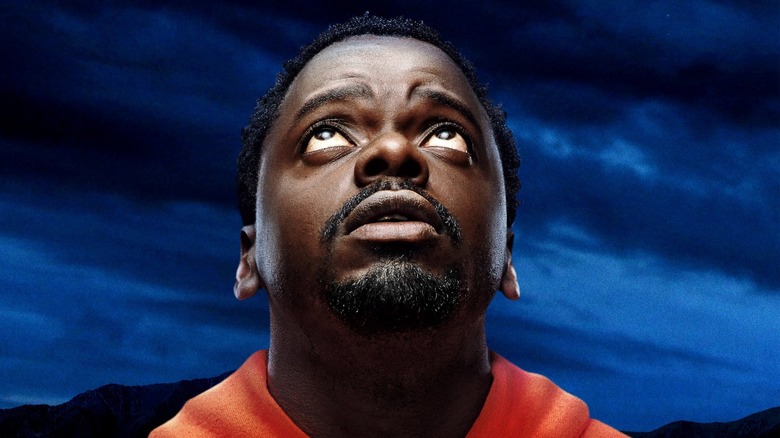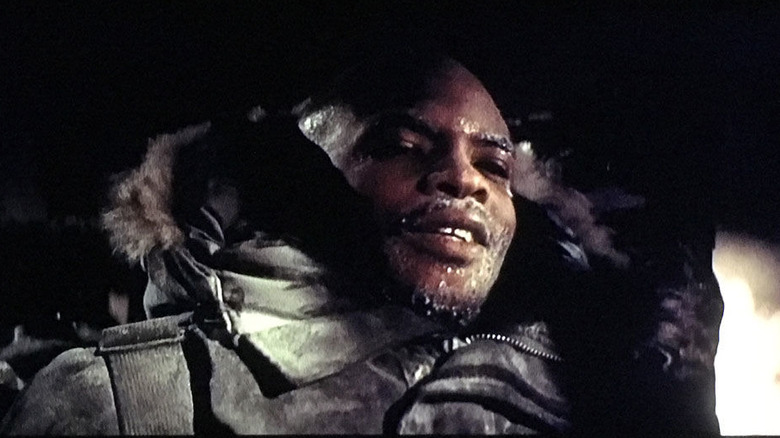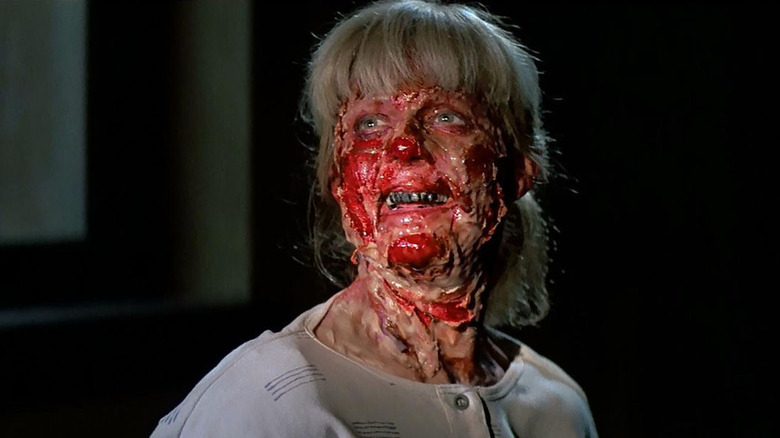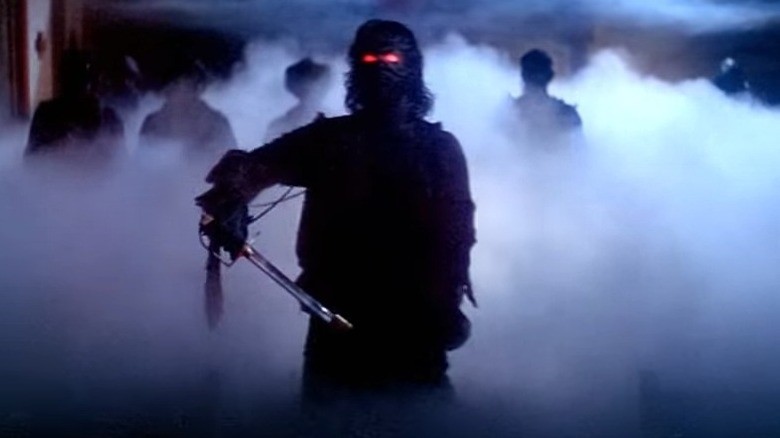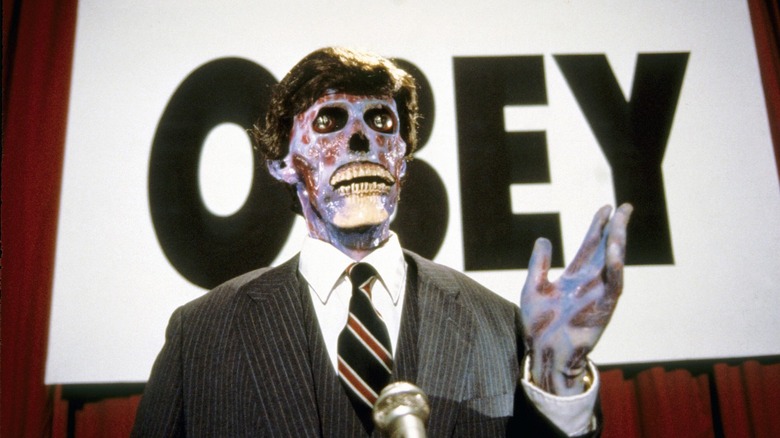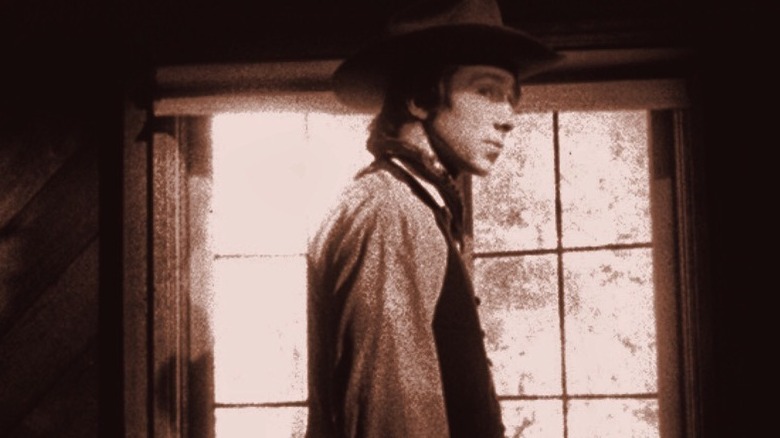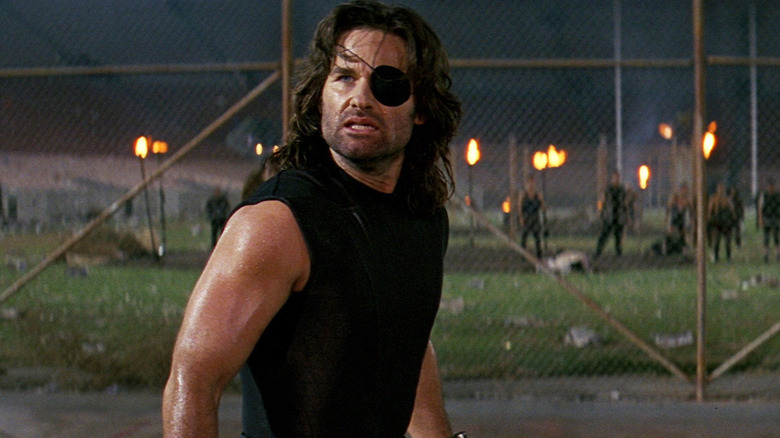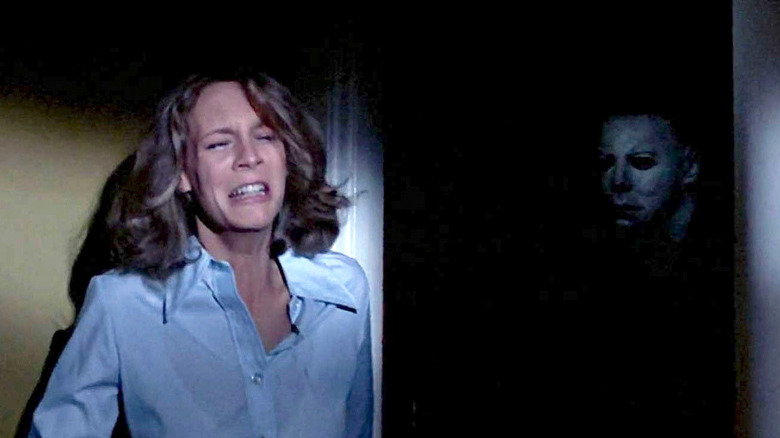All The John Carpenter Influence Found In Jordan Peele's Nope
No one wants to be the target of whatever "discourse" Film Twitter is having. More often than not, that discourse isn't a thoughtful back-and-forth conversation about movies on the internet. It's code for partaking in an exhausting tweeting cycle in which the quippiest takedown wins the most likes. What starts as one tweet about a film opinion can warp into everyone on the silly bird app weighing in on the validity of a subjective opinion. Pray it's not unpopular enough to go viral because then it spirals into a biting conversation about how others agree or disagree with you. Gross. Although tweeting about film is an invitation to play with fire, sometimes the internet plays nice and delivers a fitting end to a viral tweet.
When comic creator Adam Ellis called Jordan Peele the best horror director of all time, the internet was quick to explain how wrong his opinion was and how right they were. Hilariously, the "Nope" filmmaker jumped into the replies and tweeted back, "Sir, please put the phone down I beg you. Sorry. I love your enthusiasm but, I will just not tolerate any John Carpenter slander!!!" In a way, Peele's tweet reads like a life jacket being thrown to Ellis, pulling the internet's attention away from hating on him with kindhearted humor.
In the spirit of Peele's tweet, and because Film Twitter needs to have a bit more fun, I decided to find all the John Carpenter influence I could in "Nope."
The Thing
Of all of Jordan Peele's films, "Nope" harkens back the most to John Carpenter's sci-fi horror classic, "The Thing." The most obvious comparison between the 1982 film and "Nope" is that both films star genre legend Keith David in a commanding role while alien[s] run amok. On a deeper level, "Nope" depicts its aliens much like "The Thing" does.
Both sci-fi horror films initially show aliens as familiar images — a flying saucer or a husky dog — but their true natures are far more disturbing. We never see the original form of the Thing in Carpenter's film. All we know is it consumes and morphs its DNA to match every being it has eaten. Likewise, the alien in "Nope" is hidden from the viewer. We know it has a membrane-filled eye-mouth that swallows up bodies for sustenance while spitting out their blood, but we never see the form of the alien. The closest look we get at it is from the perspective of someone eaten by it. We see sacks of flesh — both alien and human — and a praying mantis-like head inside its body. Both films show gnarly and territorial aliens while concealing just enough about them to creep us out.
Prince of Darkness
John Carpenter's "Prince of Darkness" embodies all the bad-trip psychedelic dread that cosmic horror fans desire. Satan is, in part, a mysterious green goo. Unwitting college students become possessed and turn into hungry zombies. Jesus is an alien traveler. Messages about the future are transmitted to those involved while they're in a dream state.
Admittedly, "Nope" is not as bonkers nor delightfully strange as "Prince of Darkness." Watching the two back to back makes "Nope" seem like a tragic story about American capitalism. That's partially true, but "Nope" still takes some ambitiously fun swings with its horror set-pieces and tilting camera angles in a Carpenter-esque way. Most notably, "Nope" has a house dripping with blood and like "Prince of Darkness," it plays with splatter and bug imagery. True, there's no chest full of beetles in "Nope," but both films employ bugs to foreshadow impending doom. Whenever a praying mantis appears on screen in "Nope," it warns the Haywood family that the alien is coming for them soon.
The Fog
Whatever horror subgenre John Carpenter is playing with, he loves to center his plots on a group against an oppressive force. What makes his work scary is how his panicked characters cause just as much chaos as whatever force they're fighting. In "Halloween," it's Michael Myers the unsuspecting teens of Haddonfield. In "The Thing," it's the base camp against the alien force trying to tear them apart. Us vs. them is a clear theme in his work, and it's shown best in his 1980s film "The Fog." More of a ghost story than anything, "The Fog" tells the story of a town with a dirty secret. The terrible past of Antonio Bay is exposed once dead mariners return to wreak vengeance.
Jordan Peele's "Nope" follows a similar setup. It's a tale of a town versus a monster. Allies are found and picked off one-by-one by the unknowable force that seemingly arrives out of nowhere. "Nope" isn't an alien origin story, so we never know why the alien appears when it does. It preys on the Haywood family, and Jupiter's Claim, pitting the town against the UFO in a way that is similar to "The Fog." While the Haywood family didn't cause the alien to appear, they're not guiltless. Everyone's greedy desire to capture the alien's image inadvertently kills several tourists and residents, a fact that's just as shameful as the murders that the Antonio Bay founders committed to secure their wealth.
They Live
Written and directed by John Carpenter, "They Live" critiques the dangers of capitalism. Carpenter's film debuted as Ronald Reagan's presidency was coming to an end. The era of "Reaganomics" ushered in an approach to free-market economics that forever changed the country. Reagan erroneously thought if the wealthy had more money, they would expand their businesses and theoretically create more jobs. Historically, we know that did not happen and a trickle-down economy doesn't create more jobs or equitable wealth. Carpenter had a lot of feelings about this unseemly time in history and used "They Live" as a way to humanize the working class while dehumanizing the extremely wealthy. Everyone in power is a corrupt alien. Notably, this film also stars Keith David, but this one lets more of David's natural comedy skills come to the surface, as his character Frank Armitage vows to free Americans from alien mind control.
Like Carpenter, Jordan Peele is not subtle about critiquing America's relationship with money and the power it wields. While the alien in "Nope" doesn't control any governmental office, it does expose the Haywood family's desire for wealth. Getting that "Oprah shot" was never something they needed to do, but the promise of financial success — and the power that brings — was enough to risk their lives for it. While we understand why the financially struggling Haywood family does what they do, we hate the system that forces them to do it.
The Resurrection of Broncho Billy
I have no idea if Jordan Peele ever watched "The Resurrection of Broncho Billy," but as a total film nerd that loves John Carpenter and was crafting a modern-day Western, I bet he did. The 1970 short is one of the first films that Carpenter composed music for, wrote, and edited. Unlike his horror work, this short is more of an imaginative slice-of-life story that dips its toes into genre. The short film follows a young man who dreams of living in the sepia-toned world of the Old West. He has visions of saloons and showdowns as he lives his run-of-the-mill life and goes to work. To achieve this effect, the film alternates between a present-day setting and the Wild West.
In some ways, Ricky (Steven Yeun), the cowboy wannabe in "Nope," seems a lot like the young man in "The Resurrection of Broncho Billy." His tourist ranch, Jupiter's Claim, has all the stereotypical trappings of a Western. Just as Carpenter's character took all he knows about the West from old movies, Ricky grew up in Hollywood, not around livestock, so his commercial cowboy take seems fitting. Peele's imagery in "Nope" takes a similar approach. At times, we're in a Circuit City-like tech store. Other times, we're surrounded by dust-blown sand and an old house that makes the period a bit hazy. Both films carefully — and sometimes sillily — evoke Western sensibilities, showcasing both creators' artistic range.
Escape from L.A.
You can't set a film in Los Angeles without touching upon the influence Hollywood has on anyone who steps foot in the City of Angels. If you're wondering how John Carpenter feels about the glamour of the stardom-fueled city, the image of Snake Plissken (Kurt Russell) swinging from a burning Hollywood sign in "Escape From L.A" states it best. As with "They Live," Carpenter uses spectacular action set-pieces in the underrated 1996 film to highlight social issues. "Escape From L.A.," ambitiously tackles social issues like L.A.'s deportation rate, the toxicity of celebrity culture, and America's wealth gap. All the while, it's still a fun popcorn flick. This approach 100-percent feels like something Peele has taken to heart.
Discussing his intent with "Nope," Jordan Peele told Variety, "We tried to make a big summer blockbuster that you can enjoy whatever way you want. If you want to go in, and you just smoked a big blunt, and you want to talk to your friend about some societal issues, you can do that. If you want to come and just relax and get away from it all and see Keke Palmer in the midst of a UFO, then that's what we got for you." Although "Nope" on the surface is a sci-fi-action-horror film, it's also about the lengths that people will go to find fame and attention. In the end, much like the city of L.A. in Carpenter's film, everyone is consumed by the success they chase.
Halloween
No matter how wild John Carpenter and Jordan Peele's concepts get in their horror films, their characters always seem grounded. Carpenter succeeds best with crafting realistic characters in 1978's "Halloween." Before Michael Myers somehow gained combat skills and superhero strength in David Gordon Green's disjointed entries, the Shape was just a man. The most chilling visuals in 1978's "Halloween" are when Michael is staring through a window at the unsuspecting Laurie Strode (Jamie Lee Curtis). Nothing is supernatural about him. What's scary about Carpenter and Debra Hill's story is the ordinary way in which Michael is filmed. He's quietly stalking and killing teens. No one seems to notice this but the viewer. There's a day-in-the-life-like feeling in how the camera follows Michael, suggesting the terrifying potential that this could actually happen.
"Nope" succeeds as an alien-chase film because we care about the Haywood family's survival. If Daniel Kaluuya's OJ and Keke Palmer's Emerald didn't feel like real people with complicated desires and a tentative bond, we wouldn't care if an alien ate them. Peele keeps the spectacle of the set-pieces in "Nope" full-blown while never making anything about OJ or Emerald supernatural. They're people who just so happen to find themselves in extraordinary circumstances. They have no quippy catchphrases or fancy weapon training. They have an army of inflatable men and a roll-of-the-dice shot to survive terrible odds.
